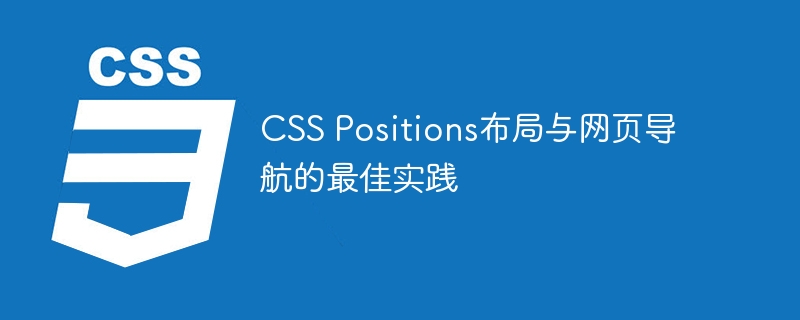Home > Article > Web Front-end > Best Practices for CSS Positions Layout and Web Page Navigation

Best practices for CSS Positions layout and web navigation
Navigation is one of the very important elements in web design. It not only helps users quickly browse the different parts of the website The page can also provide navigation bar design and layout methods that can be implemented using different CSS Position properties.
The CSS Position property defines the position of an element in the document and controls the relative relationship of the element to other elements. In the layout of web navigation, the following three common Position attribute values are usually used: static, relative and fixed. The best practices for these three properties are introduced below and corresponding code examples are provided.
Static positioning is the default positioning method of elements. Elements are laid out in the order in which they appear in the HTML document. In web navigation, static positioning is usually not used because it cannot achieve a fixed position of the navigation bar.
Code example:
<nav>
<ul>
<li><a href="#">Home</a></li>
<li><a href="#">About</a></li>
<li><a href="#">Services</a></li>
<li><a href="#">Contact</a></li>
</ul>
</nav>
<style>
nav {
background-color: #333;
color: #fff;
}
nav ul {
list-style: none;
margin: 0;
padding: 0;
display: flex;
}
nav ul li {
margin-right: 10px;
}
nav ul li a {
color: #fff;
text-decoration: none;
}
</style>Relative positioning is relative to the original position of the element itself. By setting top , right, bottom and left attribute values, you can offset the element relative to its normal position.
In web navigation, relative positioning can be used to adjust the position of the navigation bar, such as placing the navigation bar at a fixed position at the top of the page while retaining the normal flow layout.
Code example:
<nav>
<ul>
<li><a href="#">Home</a></li>
<li><a href="#">About</a></li>
<li><a href="#">Services</a></li>
<li><a href="#">Contact</a></li>
</ul>
</nav>
<style>
nav {
background-color: #333;
color: #fff;
position: relative;
top: 0;
left: 0;
width: 100%;
}
nav ul {
list-style: none;
margin: 0;
padding: 0;
display: flex;
}
nav ul li {
margin-right: 10px;
}
nav ul li a {
color: #fff;
text-decoration: none;
}
</style>Fixed positioning is based on the browser window, and the position of the element will not change. changes as the page scrolls. Fixed positioning is often used to create a navigation bar that stays fixed at a certain location on the page.
Code example:
<nav>
<ul>
<li><a href="#">Home</a></li>
<li><a href="#">About</a></li>
<li><a href="#">Services</a></li>
<li><a href="#">Contact</a></li>
</ul>
</nav>
<style>
nav {
background-color: #333;
color: #fff;
position: fixed;
top: 0;
left: 0;
width: 100%;
}
nav ul {
list-style: none;
margin: 0;
padding: 0;
display: flex;
}
nav ul li {
margin-right: 10px;
}
nav ul li a {
color: #fff;
text-decoration: none;
}
</style>Summary
By using different CSS Position properties, we can achieve different web page navigation layouts. Static positioning is used for the default flow layout, relative positioning is suitable for fine-tuning the layout of elements, and fixed positioning is suitable for creating fixed navigation bars.
When designing web page navigation, we need to select the appropriate CSS Position attribute according to the specific situation, and make corresponding style adjustments according to needs. The above code examples provide some best practices and hope to provide some help for your web navigation design and layout.
The above is the detailed content of Best Practices for CSS Positions Layout and Web Page Navigation. For more information, please follow other related articles on the PHP Chinese website!